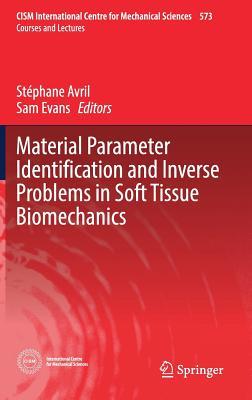Read online Material Parameter Identification and Inverse Problems in Soft Tissue Biomechanics - Stephane Avril file in ePub
Related searches:
Material Parameter Identification and Inverse - SpringerLink
Material Parameter Identification and Inverse Problems in Soft Tissue Biomechanics
Material Parameter Identification and Inverse Problems in - Springer
Characterisation and Parameters Identification of Materials
Material Parameter Identification and Inverse Problems in
Material parameters identification and experimental
Considerations on parameter identification and material
Material Parameter Identification and Optimal Technological
Identification of Material Parameters with LS-OPT® - LS-DYNA and
Table of Contents: Material Parameter Identification and
Parameter identification and shape optimization SpringerLink
Parameter identification methods for visco- and hyperelastic
Material parameter identification and inverse problems in soft tissue biomechanics by stéphane avril, sam evans, jun 28, 2018, springer edition, paperback.
The identification of the material parameters, for a given constitutive model, can be seen as an inverse formulation. In this context, the key idea is to simulate the performed experiment, trying to adapt material parameters in order to numerically obtain the same results as the experimental ones.
26 nov 2020 to evaluate gao technique, the identification problem of 7 material parameters of a specific biomechanical law is approached by multiple.
Christian ilg1, andré haufe1, david koch1, nielen stander2, katharina.
Material parameter identification and inverse problems in soft tissue biomechanics / the articles in this book review hybrid experimental-computational methods applied to soft tissues which have been developed by worldwide specialists in the field.
A novel method for the whole identification process for a numerical material model in terms of a linear gener- alized maxwell model (prony-series) based on exper- imental data will be presented. Furthermore, material parameters for different hyperelastic material models based on experimental investigations will be shown and compared.
Material parameters identification: gradient-based, genetic and hybrid optimization algorithms.
Especially, the simulation results depend largely on the material model and on the material parameters.
Constitutive modeling requires the calibration of the constitutive model to experimental data.
Material parameter identification and inverse problems in soft tissue biomechanics volume 573 of cism international centre for mechanical sciences: editors: stéphane avril, sam evans: edition: illustrated: publisher: springer, 2016: isbn: 3319450719, 9783319450711: length: 144 pages: subjects.
In this paper we describe the extension of our parameter identification algorithm for extracting the full parameter set of piezoelectric materials.
People developing computational models of soft tissues and organs will find solutions for calibrating the material parameters of their models; people performing.
In the present paper, two types of inverse approaches will be discussed, namely the parameter identification and the shape optimization problems. The aim of the former is to evaluate the input parameters for material constitutive models that would lead to the most accurate set of results respecting physical experiments.
Material parameter identification and inverse problems in soft tissue biomechanics.
The model is highly flexible and provides a frame- work inside ls-dyna in which failure parameters can be tuned to reproduce experimental data.
However, parameter identification of the hyperelastic material properties of plantar soft tissues usually requires an inverse finite element analysis due to the lack of a practical contact model of the indentation test.
The materials will be provided prior to the lectures and exercises. Contents: the calibration of parameters plays a central role in establishing predictively accurate.
A material parameter identification is presented for a fully thermo- mechanically coupled material model based on full field displacement and temperature.
Characterisation and parameters identification of materials constitutive and damage models: from normalised direct approach to most advanced inverse.
The results yield homogenized material parameters for the pla stack as a function of material parameter identification for acoustic simulation of additively.
In the four basic factors on the intellectualization of sheet metal forming, the real-time identification of the material performance parameter and the prediction of the optimum technological parameter are the two most complicated technical keys. The accuracy of identification and prediction will have direct effect on the success of the intelligent control.
19 sep 2014 abstractthis paper proposes a novel framework that combines high-fidelity mechanics-based nonlinear (hysteretic) finite-element (fe) models.
11 feb 2018 thus, available studies on identification of thermo-elastic parameters are limited when compared to only elastic materials.
In addition to the theoretical background taught at the c1511 cism school in 2015, it is planned for this new course to have hands-on sessions for a better practice of material parameter identification and inverse problems in soft tissue biomechanics.
Material parameter identification and inverse problems in soft tissue biomechanics. By� cism international centre for mechanical sciences (book 573) thanks for sharing! you submitted the following rating and review.
A material parameter identification is presented for a fully thermo-mechanically coupled material model based on full field displacement and temperature measurements.
The numerical identification of the material parameters is obtained by a careful population-based stochastic optimization approach. After testing the stability of our numerical approach, based on a large number of numerical experiments, we deduce that our constitutive model and the or model are the most accurate.
2 dec 2019 procedural material models have been gaining traction in many applications thanks to their flexibility, compactness, and easy editability.
Abstract this paper presents two procedures for the identification of material parameters, a genetic algorithm and a gradient-based algorithm. These algorithms enable both the yield criterion and the work hardening parameters to be identified.
Parameter identification is a class of inverse problems which determines material or system parameters from a known experimental response. There are basically two general strategies for obtaining inelastic parameters in mechanical problems: (i) calibration procedures assuming uniform stress states and (ii) identification by using optimization techniques.
Material parameter identification and inverse problems in soft tissue biomechanics people developing computational models of soft tissues and organs will find.
This paper addresses this problem and provides optimal material parameters by fitting the fea model to an existing loudspeaker prototype measured by laser.

Post Your Comments: